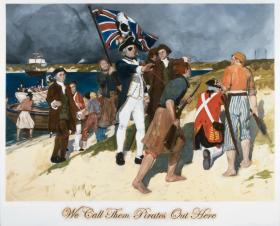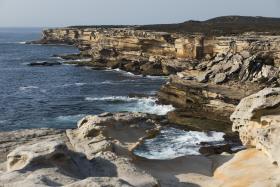Eight days in Kamay – texts and the human experience
Key inquiry question #1
Eight Days in Kamay — online exhibition
Text Type
Website
Key questions
- What aspects of human experiences are represented in texts?
- How do texts represent these aspects of human experiences?
- How well do texts represent aspects of human experiences?
Learning Intention
Students are learning to:
- understand, interpret and critically analyse a complex digital text
- think interpretively and discerningly about new ideas presented in a digital text
Success Criteria
Students will be successful when they can:
- analyse the purpose and context of the online exhibition
- describe and evaluate the use of structural, stylistic and linguistic elements to represent diverse human experiences and perspectives
Background notes for teachers and students
First voyage of the Endeavour
On an expedition that took them 1050 days and around the world, Lieutenant James Cook and 93 other crew and expedition members onboard HMB Endeavour were the first known Europeans to sight and chart the east coast of Australia, in 1770. They entered Kamay (Botany Bay) on 29 April 1770, forced their way onto the shore, and spent eight days collecting specimens and exploring before setting sail once more.
Kamay
James Cook, Joseph Banks and the crew of the Endeavour were in Kamay for eight days out of a 1050-day journey. Although this was a short time in the history of the Aboriginal people of Australia, who have inhabited this land for more than 65,000 years, the ramifications of these eight days were to be enormous for both the Aboriginal people of Australia and all those who have since moved to these shores.
The exhibition Eight Days in Kamay explores the visit of James Cook, Joseph Banks and the crew of the Endeavour to the shores of Kamay, telling the story largely from an Indigenous perspective. You can visit this exhibition online.
1970 Day of Mourning
The 200th anniversary of the Endeavour’s arrival in Kamay was marked in 1970. While celebrations and commemorations, including re-enactments, were held across the nation, for Indigenous Australians the anniversary was not cause for celebration. Instead, a ‘Day of Mourning’ was declared, and protests held. A feature of these protests was the wearing of red headbands, meant to symbolise the blood shed by Aboriginal and Torres Strait Islander peoples on that day in 1770 and since.
Indigenous cultural systems
Country
When used by Aboriginal and Torres Strait Islander people, the term Country encompasses the lands, waterways, skies and seas. However, it is much more complex than just a collective term for physical land formations. Country speaks to complex ideas about every aspect of life. Not only is Country a place to call home, but it informs laws, customs, responsibilities, spiritual beliefs, cultural practices, family, identity and language. Compounding the complexity of the term further, is the idea that Country also informs physical and emotional relationships with the ancestral beings that inhabit places within Country and as such; Country is animate (alive) for Aboriginal and Torres Strait Islander peoples.
Ancestors play a significant role in the way in which Country has come to exist, and the relationship of Aboriginal and Torres Strait Islander people to Country. The ancestors’ legacy in Country informs the complex social rules and kinship relationships that guide how people live, the names of places in Country, the language people speak and the songs and ceremonies required to keep the Country and its people healthy.
Despite popular assumptions, Aboriginal people were not opportunistic in the use of resources, but managed Country via highly complex systems, developed over thousands of years, that dictated patterns of hunting, fishing and agriculture. With extensive ecological knowledge, Aboriginal peoples lived a highly sustainable life.
Language
Approximately 250 distinct languages, and many hundreds of dialects, were spoken across Australia. Maps of language groups provide only an approximation of ‘boundaries’ as mapping traditional territories is very complex, requiring an understanding of the travels of ancestors through the land.
Kinship
Kinship locates all Aboriginal and Torres Strait Islander people in networks of belonging and webs of relationships that include not just people, but places, plants, animals and ancestors. Whilst the exact nature of kinship varies from place to place, it generally works to group together certain relatives, allocate specific roles and responsibilities, and dictate rules about marriage and contact between people. The principles of kinship remain very important for Aboriginal and Torres Strait Islander peoples today.
Student Activities
Who discovered who?
Students connect with their own prior knowledge before exploring different ways of thinking about and representing historical events. Students come to an understanding of the diverse ways that people view and experience the world through investigating oral and written recounts of Cook’s arrival in Kamay (Botany Bay).
A modern response to Cook
Through an examination of contemporary and historical artworks, students analyse and evaluate the ways in which art presents an alternative perspective. Students will think interpretively and discerningly about the ways that visual features and the composition of contemporary artworks can be used to challenge society’s beliefs and assumptions about Cook’s arrival at Kamay (Botany Bay).

Memorial and Protest
Students investigate how stylistic choices can be used to represent different perspectives and attitudes. They will assess the impact of context on shaping societal understanding and commemoration around Cook’s 8-day incursion at Kamay (Botany Bay) in 1770 and discuss how responses to Indigenous voices vary over time.

Seeing the world differently
Students will appreciate the value of thinking about stories from the past in different ways and will compose a persuasive text evaluating the power of the online exhibition, its stylistic and structural features and its significance in influencing and positioning viewers.

NSW SYLLABUS FOR THE AUSTRALIAN CURRICULUM ENGLISH
A student:
- independently responds to and composes complex texts for understanding, interpretation, critical analysis, imaginative expression and pleasure (EN12-1)
- analyses and uses language forms, features and structures of texts and justifies their appropriateness for purpose, audience and context and explains effects on meaning (EN12-3)
- thinks imaginatively, creatively, interpretively, analytically and discerningly to respond to and compose texts that include considered and detailed information, ideas and arguments (EN12- 5)
- explains and evaluates the diverse ways texts can represent personal and public worlds (EN12-7)
A student:
- independently responds to, composes and evaluates a range of complex texts for understanding, interpretation, critical analysis, imaginative expression and pleasure (EA12-1)
- critically analyses and uses language forms, features and structures of texts justifying appropriateness for specific purposes, audiences and contexts and evaluates their effects on meaning (EA12-3)
- thinks imaginatively, creatively, interpretively, critically and discerningly to respond to, evaluate and compose texts that synthesise complex information, ideas and arguments (EA12-5)
- evaluates the diverse ways texts can represent personal and public worlds and recognises how they are valued (EA12-7)
Learning across the curriculum
- Aboriginal and Torres Strait Islander histories and cultures
- Civics and citizenship
- Difference and diversity
General capabilities
- Critical and creative thinking
- Information and communication technology capability
- Intercultural understanding
- Literacy
Across Stage 6, the selection must give student experience of:
- a range of types of texts inclusive of prose fiction, drama, poetry, nonfiction, film, media and digital texts.
- a range of Australian texts, including texts by Aboriginal and/or Torres Strait Islander authors and those that give insights into diverse experiences of Aboriginal and/or Torres Strait Islander peoples
- texts with a wide range of cultural, social and gender perspectives
- integrated modes of reading, writing, listening, speaking, viewing and representing as appropriate.